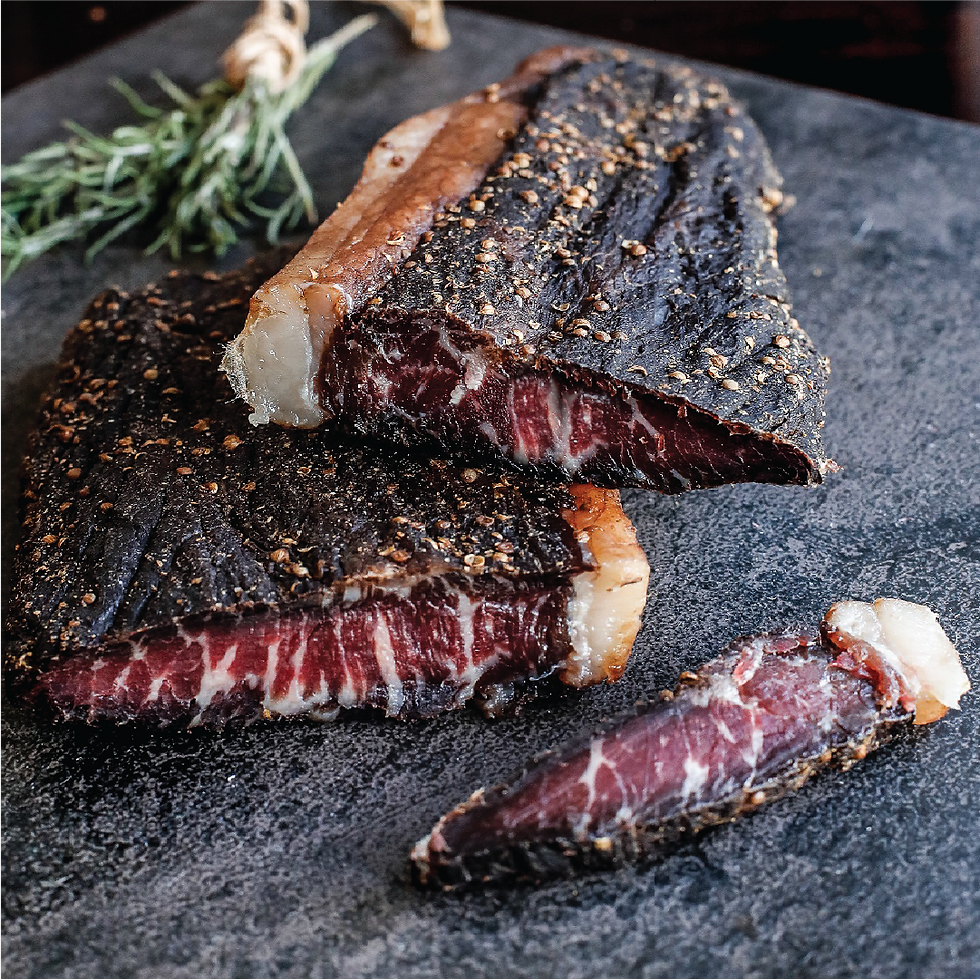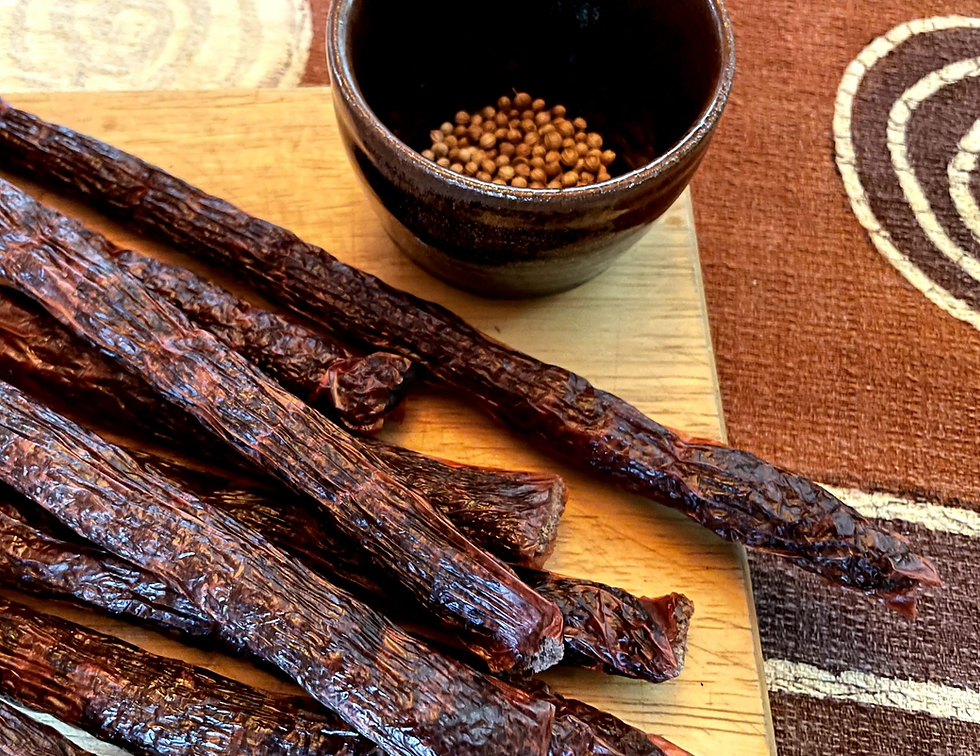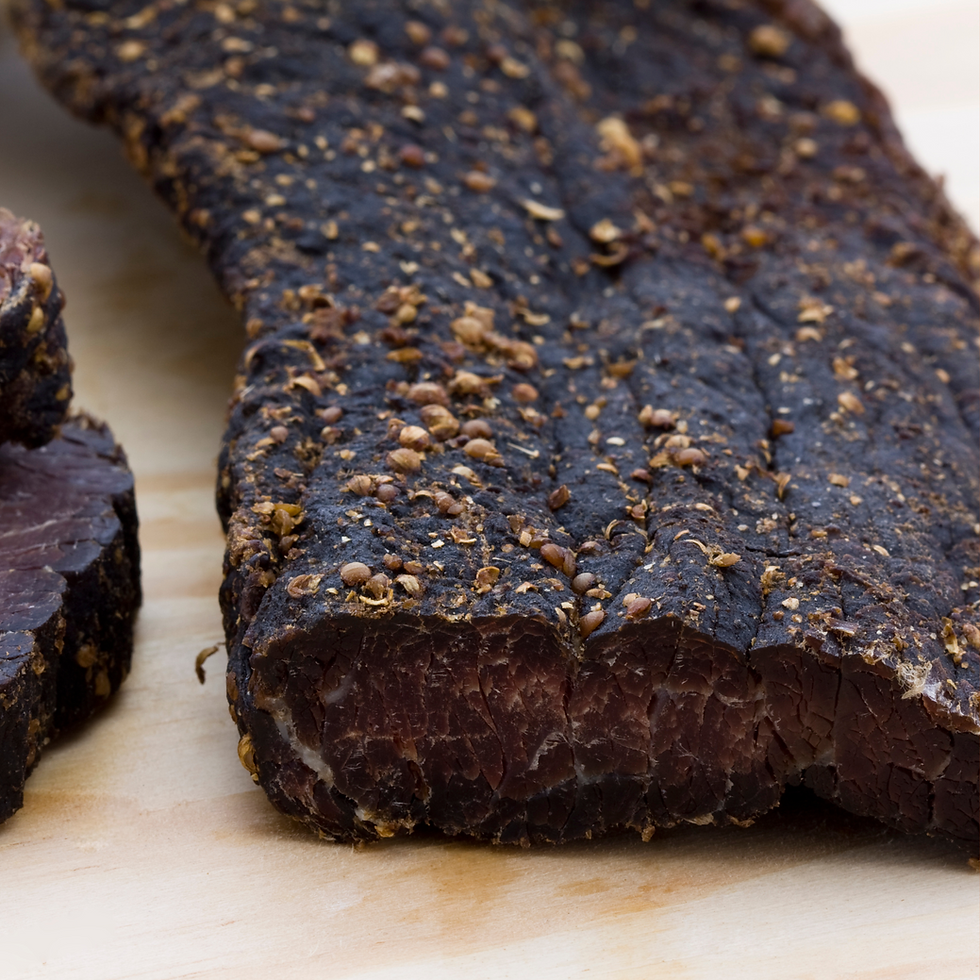Biltong for the Body: The Health Benefits of South African Cured Meats
- Chef Rod

- Jul 4
- 4 min read

Hey Skinny Readers! How are you all doing? From my side, let’s just say—some of us have been hustling through the concrete jungle lately, ha-ha! (But we’ll keep that cured for next week’s episode.)

Today is the 4th of July—Independence Day in the USA and also National Caesar Salad Day! While many over there are lighting up their grills with burgers, hot dogs, seafood, and those infamous ribs, let’s be real—no one does fire like South Africans!
And that brings us to this week’s sizzling topic…
What is Biltong?

Once a staple snack in the South African bush, biltong is now popping up in gym bags, lunchboxes, and Keto kitchens around the world. But here’s the question, Skinnies—is this dried delicacy just tasty, or actually good for your body?
Biltong is dried, cured meat—usually beef, but it can also come from game like kudu or ostrich. It hails proudly from South Africa and is often compared to American jerky. However, unlike jerky, biltong isn’t smoked or overly sweet. Traditionally, it was dried by hanging strips on trees, with the sun and wind doing the magic.
The meat is cured in vinegar and spices, then air-dried—giving it that rich, bold flavor and unique texture. Originally developed by Afrikaner trekkers as a way to preserve meat during tough times, this practice turned into a delicious and protein-rich tradition. In fact, 100g of biltong can pack up to 67g of protein—that’s nearly double its original weight in raw meat!
But hold up, Skinnies—as with all good things, moderation is key. So let’s break it down: the pros and cons of biltong for your body.
Biltong for the Body: Pros and Cons

✅ PROS of Eating Biltong
High in Protein
Around 25–30g per 100g—perfect for:
Supporting muscle growth and repair
Keeping you fuller for longer (hello appetite control!)
Active lifestyles, workouts, or high-protein diets
Low in Carbs and Sugar
Traditional biltong is naturally low in sugar and carbs, making it:
Ideal for Keto, low-carb, and diabetic-friendly diets
A great alternative for those cutting processed sugars
Nutrient-Rich Goodness
Packed with:
Iron – boosts red blood cell production
Zinc – supports immunity and metabolism
Vitamin B12 – key for energy and nerve health
Creatine – great for athletic performance
❌ CONS of Eating Biltong
High in Sodium
Salt is essential for curing, but commercial brands often go overboard.Watch out for:
Elevated blood pressure (especially in salt-sensitive folks)
Water retention
Risk of Additives in Store-Bought Biltong
Mass-produced versions might include:
Preservatives like nitrates or sulfites
MSG or other flavor enhancers
Added sugars or soy
🧠 Quick Tip: Read the label—or better yet, make your own at home to control what goes in!
Calorie Dense
While leaner than other meats, biltong is energy-dense and easy to over-snack on.(Just ask Shadre, haha—might get into trouble for that one!)
Fatty cuts or certain game meats = higher in calories🧠 Quick Tip: Stick to 30–50g portions for healthy snacking.
How to Make Your Own Homemade Biltong Traditional Clean Version:

Ingredients:
1–2 kg lean beef (silverside, topside, or game like kudu/ostrich)
3 tbsp apple cider vinegar or malt vinegar
2 tbsp coarse salt (preferably Himalayan or sea salt)
1 tbsp cracked black pepper
1 tbsp ground coriander (lightly toasted)
Optional: Pinch of bicarbonate of soda (for tenderness)
Optional: Chili flakes or smoked paprika for a flavor kick
Steps:
Slice meat into long strips (1.5–2 cm thick, with the grain).
Marinate with vinegar for 2–4 hours in the fridge.
Rub spices evenly into the meat after soaking.
Layer in a shallow tray, cover, and refrigerate overnight (up to 24 hours).
Hang in a biltong box or ventilated space at 18–22°C.
Dry for 4–7 days depending on thickness and taste.
Health Tips:
Trim visible fat to reduce spoilage and saturated fats
Use apple cider vinegar for probiotic benefits
Avoid sugary marinades
Store in paper (never plastic!) in a cool, dry spot
Healthier Droëwors (Dried Sausage)

Ingredients:
1 kg lean beef mince (or a beef/game mix)
100–150g beef fat (for balance—not too much!)
1 tbsp vinegar
1 tbsp salt
1 tsp black pepper
2 tsp coriander
½ tsp clove or nutmeg (optional)
Sheep casings
Steps:
Mix all ingredients (keep meat very cold).
Stuff into casings using a sausage maker.
Twist into 10–15 cm sausages.
Hang to dry for 3–5 days.
Health Tips:
Keep fat to a minimum for a drier texture
Don’t over-salt—1.5–2% of meat weight is ideal
Avoid MSG or sugar-laced spice mixes
Other South African Cured Meats to Try
🔥 Chili Bites (Biltong Snapsticks)

Use lean meat strips
Marinate in vinegar + chili-coriander mix
Dry flat or hanging—done in 2–3 days
Perfect for low-fat snacking
🦌 Venison Biltong

Great with kudu, springbok, or eland
Leaner than beef—requires shorter drying
Richer taste, ideal for lower-fat diets
Do You Need a Biltong Box?

A biltong box ensures proper airflow and protection from bugs/dust. You can DIY one using:
A wooden or plastic box
A small fan for ventilation
1–2 light bulbs for gentle warmth (optional)
Hanging hooks or dowels
Bonus: Air drying preserves nutrients better than ovens or dehydrators, which may "cook" the meat.
Final Tips for Healthy Homemade Cured Meats

✅ Do | ❌ Don’t |
Use lean meat and trim all visible fat | Overdo it with salt or spice rubs |
Use vinegar and natural spices | Use MSG- or sugar-filled premixes |
Dry in a cool, well-ventilated area | Dry in the sun or damp spaces |
Store in paper or breathable bags | Store in airtight plastic containers |
A Final Slice of Wisdom
“Biltong may be dried, but your lifestyle doesn’t have to be. ”Whether you're hiking the Drakensberg, crunching numbers at your desk, or just hunting for a smarter snack—biltong brings the bite and the benefits.
So remember, Skinnies: It’s a snack, not a meal, a flavor, not a food group, and a South African tradition worth savoring—respectfully and healthily.
Now let’s hit it—hang some meat, flex your muscles, and chew like a champ. Although we are moving places, let’s meet same place, same time, and most importantly—stay safe, and stay skinny!
Creative Director : Shadre Leonard
1
Searing the Beef
Sear beef fillets on high heat for 2 minutes per side to form a golden crust. Let it cool before proceeding to keep the beef tender.
1
Searing the Beef
Sear beef fillets on high heat for 2 minutes per side to form a golden crust. Let it cool before proceeding to keep the beef tender.
1
Searing the Beef
Sear beef fillets on high heat for 2 minutes per side to form a golden crust. Let it cool before proceeding to keep the beef tender.
1
Searing the Beef
Sear beef fillets on high heat for 2 minutes per side to form a golden crust. Let it cool before proceeding to keep the beef tender.
Notes



1
Season the good fresh beef fillets with salt and black pepper. Heat olive oil in a pan over high heat and sear the fillets for 2 minutes per side until it fully browned. Remove the beef from the pan and brush with a thin layer of mustard. Let it cool.



1
Season the good fresh beef fillets with salt and black pepper. Heat olive oil in a pan over high heat and sear the fillets for 2 minutes per side until it fully browned. Remove the beef from the pan and brush with a thin layer of mustard. Let it cool.



1
Season the good fresh beef fillets with salt and black pepper. Heat olive oil in a pan over high heat and sear the fillets for 2 minutes per side until it fully browned. Remove the beef from the pan and brush with a thin layer of mustard. Let it cool.



1
Season the good fresh beef fillets with salt and black pepper. Heat olive oil in a pan over high heat and sear the fillets for 2 minutes per side until it fully browned. Remove the beef from the pan and brush with a thin layer of mustard. Let it cool.
Instructions
Quality Fresh 2 beef fillets ( approximately 14 ounces each )
Quality Fresh 2 beef fillets ( approximately 14 ounces each )
Quality Fresh 2 beef fillets ( approximately 14 ounces each )
Beef Wellington

Beef Wellington
Fusion Wizard - Rooftop Eatery in Tokyo
Author Name

Beef Wellington is a luxurious dish featuring tender beef fillet coated with a flavorful mushroom duxelles and wrapped in a golden, flaky puff pastry. Perfect for special occasions, this recipe combines rich flavors and impressive presentation, making it the ultimate centerpiece for any celebration.
Servings :
4 Servings
Calories:
813 calories / Serve
Prep Time
30 mins
Prep Time
30 mins
Prep Time
30 mins
Prep Time
30 mins


Comments